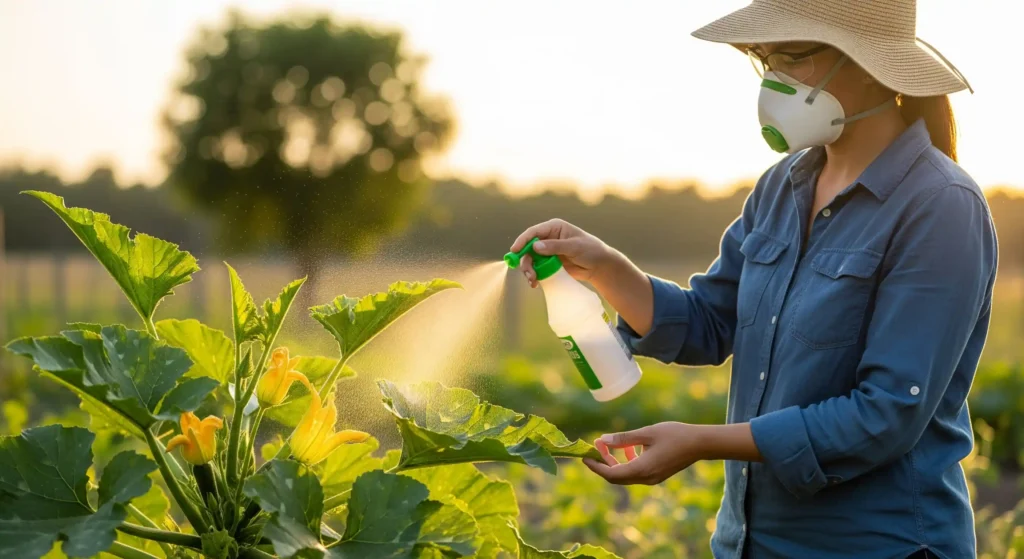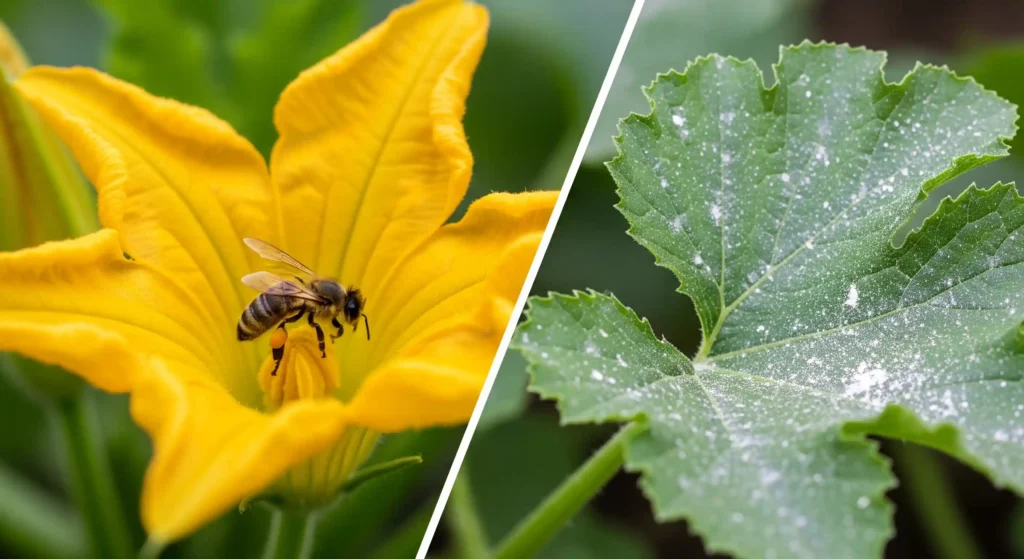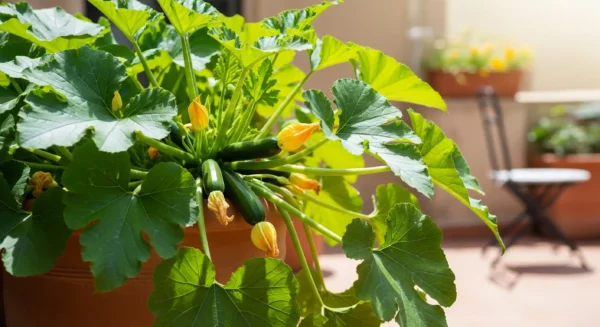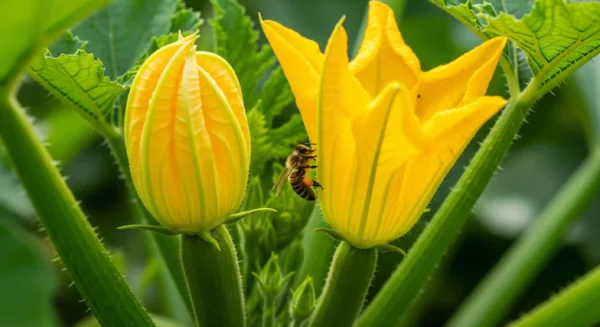A Guide to Using Diatomaceous Earth for Zucchini Pests
Is there anything in the realm of gardening that more irritates me than this? You have done exactly what is needed. You gently changed your soil in the spring, planted your zucchini seeds with great care, and have proudly watched as the large, gorgeous, umbrella-like leaves have opened. On the barbecue, the fresh, grilled spears and the future loaves of zucchini bread taste practically like one another. One morning you walk out carrying coffee and notice it. Yellow streaks speckled across the leaves define them. On the underside of a leaf, a gathering of ugly, shield-shaped insects is celebrating. Alternatively perhaps small, destructive bugs are transforming the beautiful leaves of your plant into something like Swiss cheese.
Believe me, you are not alone if the scene causes your stomach to contract. Every gardener—from the amateur to the seasoned professional—has experienced this moment. It feels personal, as if a little army has attacked your summer happiness strategically. Years of struggle with this exact issue in my own garden patch saw me helplessly watch as my promising zucchini and summer squash plants would abruptly collapse due to pests like the infamous squash bug and the unrelenting cucumber beetle. You could be thinking if there is any hope or if you are destined to either simply give up your crop or douse your future food with dangerous chemicals.
A Simple, Natural Solution
Let me slink over the virtual garden fence and reveal a secret that turned all around for me. Using diatomaceous earth for zucchini bugs is the most efficient, safe, and very straightforward approach to handle this particular problem.
Yes, it’s really simple. The answer is an all-natural, organic-approved powdered substance from the ground itself, not some convoluted chemical mix. But—and this is the key difference between a good harvest from a continuous struggle—the magic is in the approach rather than alone in the powder. Tossing it about your garden won’t have the desired effects. You must know which type to buy (and which type to avoid at all costs!), the ideal time of day to apply it for best impact, and the particular application procedures that target the pests without damaging the beneficial insects that help your garden flourish. True protection of your plants depends on these factors.
Beginning to feel somewhat more hopeful? good. Stay with me; I will lead you methodically through all. We will convert your zucchini patch into a no-go zone for those harmful pests and get you back on track to produce that mouthwatering, plentiful crop for which you have been so diligent.
Just What Exactly Is This “Magic” Garden Dust?
Alright, so I’ve been praising this ‘diatomaceous earth,’ but you might be wondering, ‘What on earth is it?’ That’s a great question since becoming a very confident gardener starts with knowing what you are putting in your yard. Although the name sounds somewhat technical and complex, the reality is quite basic and natural.

From Ancient Algae to Garden Powder
Not a man-made chemical or a pesticide in the conventional sense, diatomaceous earth (you can just call it DE, we’re buddies here) is not. Actually, the fossilized remains of single-celled aquatic life known as diatoms are far cooler. Imagine them as little, ancient algae using silica to create complex, shell-like skeletons for themselves. Great concentrations of these diatoms accumulated in the silt of rivers, lakes, and oceans over millions of years. Under a microscope, this soft, chalky powder we obtain today seems like a collection of small, hollow cylinders coated in sharp, spiky spikes. It seems to you and me as good and safe as baking flour. To a little, soft-bodied insect, however? It tells a rather different narrative.
The Golden Rule: Only Use Food-Grade DE
Please lean in close since right now this is the most crucial component of our conversation. There are several kinds of DE, and you really should only use food-grade diatomaceous earth for your garden. Often for less money, you may find something at the hardware store branded as “pool grade” or “filter grade,” DE. You should not be tempted! Heat-treated in a process known as calcination, that version alters the crystalline structure of the silica, thereby rendering it quite harmful to breath for humans and animals. Conversely, food-grade DE is amorphous silica devoid of calcsine character. That is the only type safe for your garden, your family, your dogs, and yourself. Actually, it’s quite harmless; in animal feed and as a nutritional supplement, it’s commonly used to control internal parasites. Thus, always, always search for the words “Food- Grade” on the label while you purchasing. It’s the golden rule on using DE sensibly and successfully.
How One Simple Powder Safely Guards Your Zucchini Plants
How then does this fossilized dust really work? Here is where Mother Nature’s actual genius is most displayed. DE operates in a strictly physical and mechanical manner unlike chemical insecticides that poison pests (and potentially damage a lot of other things in the process). This is the secret of why your organic garden finds such a great and safe solution.
Recall those little, pointed bits on the diatom fossils I described? Little, sharp edges in a soft-bodied insect such as a cucumber beetle moves through a dusting of DE function like tiny glass shards. Through the waxy exterior coat of the insect, sometimes known as the cuticle or exoskeleton, they scratch and cut The insect depends on this waxy layer since it controls moisture inside its body.

There is no reversing for the pest once its protective layer has been compromised. As the DE starts to devours the fats and oils (lipids) from the exoskeleton, moisture starts to flee the insect’s body. The bug starts to gently dry out basically. Not a chemical poisoning, dehydration is a mechanical process. This is the reason you won’t see bugs drop dead the second they touch; it takes a day or two to have its complete impact. But it’s quite successful.
And this is exactly why your zucchini plants, you, your dogs, and earthworms in the ground are so safe. Mammals are unaffected by it; plants cannot absorb it. Its killing effect is purely structural, and it is exactly aimed at the anatomy of the hard-shelled or waxy-bodied insects you do not wish crawling all over your vegetable field. It’s a wonderfully elegant and straightforward fix for a really bothersome issue.
Key Pests DE Can Handle: Your Zucchini’s Worst Rivals
Let’s get right to the interesting part: spotting the bad folks now that you know what DE is and how it operates. Half the fight is knowing your opponent. Here’s a quick rogue’s gallery of some of the most often occurring pests on your zucchini plants that totally detest diatomaceous earth.
- Squash Bugs: The main opponent is the shield-shaped, brownish-gray bug you find commonly in bunches. Using their piercing mouthparts to draw the sap straight out of the leaves, squash bugs cause the leaves to wither, turn yellow or brown, and finally dry and black. Against the young, soft-bodied nymphs, DE is excellent; yet, it also discourages the adults. Look for their clusters of little, bronze-colored eggs on the underside of leaves and scrape them off anytime you find them!
- Cucumber Beetles (Spotted and Striped): The evil causing your lovely leaves to become lace is cucumber beetles—spotted and striped. Cucumber beetles are voracious eaters and have both spotted and striped forms as their name would imply. They tear holes in leaves and, much more annoyingly, will destroy the blooms, therefore stopping fruit from ever developing. Worse still, they are well known for spreading horrible illnesses like bacterial wilt, which can virtually overnight kill a plant.
- Aphids: Ah, the little yet mighty aphids on zucchini. Masters of reproduction, these pear-shaped insects can create dense colonies particularly on the fragile new growth and undersides of leaves. Their sucking of the plant’s sap results in curling yellow leaves that turn stunted. Additionally left behind is a sticky residue known as “honeydew,” which can cause sooty mold.
- Squash Vine Borers: This insect is a real heartbreaker and rather different from others. A grub penetrates into the base of the stem, eating the plant from the inside out and causing the whole thing to rapidly wither and perish. DE cannot harm the grub within the stem, but it can be a strong deterrent against the adult moth that deposits the eggs. Active throughout the day, a squash vine borer moth resembles shockingly a red-and- black wasp. Dusting the base of the stem and surrounding dirt with DE makes it an unpleasant area for her to land and deposit those damaging eggs.
| Pest | Control Method |
|---|---|
| Squash Bugs | Apply DE, especially effective against young nymphs. Manually scrape bronze-colored egg clusters from the undersides of leaves. |
| Cucumber Beetles | Apply DE to leaves and blooms to combat these voracious eaters and prevent the spread of diseases like bacterial wilt. |
| Aphids | Apply DE to the undersides of leaves and new growth where colonies form to stop them from stunting plant growth. |
| Squash Vine Borer | Dust the base of the plant stem and the surrounding soil with DE to deter the adult moth from laying eggs. |
The Complete How-To: Maximizing DE Effect
Alright, let’s get our hands filthy—or, more accurately, dusty! This is where your acquired knowledge finds actual application. These guidelines will guarantee that you are utilizing DE in the most efficient manner to safeguard your valuable flora.
Step One: Select Your Weapon (Always Food- Grade!)
Although I have addressed this before, it is quite vital and should be discussed once more. Verify your diatomaceous earth bag thoroughly before starting any other project. Verify whether the label clearly states “Food- Grade”. This is your non-negotiable first step toward ensuring your family, garden, and yourself are safe.
Step Two: Everything Depends on Perfect Timing
DE suffers one main flaw: water. It works just in dry conditions. This emphasizes the need of applying it deliberately. Applying DE is best done on a calm, dry day when rain is not expected.
My best pro-tip is to head out just as the sun is rising in very early morning. Often at this time, the zucchini leaves have a faint covering of dew. Once the sun dries the fine powder, this little wetness is just enough to enable it to attach to the surfaces of the leaves, producing an ideal, even covering. It resembles a natural glue.
This also leads us to a vital rule: you have to reapply diatomaceous earth following every major rainfall. A severe downpour will wash away all the protecting coating, thereby exposing your plants to once more vulnerability. Consider it as giving the plant fresh armor renewal.
Step Three: Application Techniques—Dry vs. Wet
You have two excellent choices for implementing DE; the one you decide upon may rely on your personal inclination and the equipment you own.

- The Dry Method: The most often used and, in my view, most straightforward approach is the Dry Method. To produce fine, light dust, you will want an applicator with good control. Perfect for this is a dedicated powder duster—also known as a bulb duster or puffer. Should you not have one, hardly cause for concern! Like one for ketchup or mustard, an empty, well cleaned plastic squeeze bottle performs miracles. The work can be accomplished using even a basic, classic flour sifter or fine-mesh strainer. Your aim is not a heavy cluster but a delicate, visible film. You want to lightly dust the whole plant, especially paying close attention to the underside of leaves where bugs love to hide and deposit eggs. Puff some around the base of the stem on the ground surface to discourage squash vine borer moths and crawling insects. Too much can obscure sunlight and reduce effectiveness.
- The Wet Method: This is great for minimising flying dust and for getting the powder to stick. You just toss the food-grade DE with water in a garden sprayer. About four tablespoons of DE for every gallon of water makes a reasonable beginning ratio. The DE will like to settle at the bottom, hence shake the sprayer often while you work. Again concentrating on the tops and bottoms of leaves, spray every surface of the plant. It will first seem as though you have misted your plants with foggy water. But the beautiful, homogeneous layer of that pest-fighting diatomaceous earth will be left behind as the water evaporates. This is a quite orderly approach of finishing the task!
The Conscientious Gardener: DE Wisely
Great power comes with great responsibility, and that is true even for natural gardening techniques. Though DE is a great tool, its influence is non-selective. This implies that, although it operates physically, it cannot distinguish a “bad bug” such as a cucumber beetle from a “good bug” such as a ladybug or, most significantly, a honey bee. Being a very good gardener entails looking after your plants as well as the ecology they support.
This leads us to the most important factor while applying DE: safeguarding our pollinators. To produce fruit, zucchini plants need pollination; our dear bees and other helpful insects handle that task. We desire nothing but to not hurt them. Fortunately, with some careful timing, safeguarding them is easy.

Apply DE late in the evening or very early in the morning when our dear bees are not active to guard them. Most importantly, steer clear of dusting the zucchini flower open blossoms themselves. Flying from bloom to bloom, bees are most active in the sunlit hours of the day. Applying the dust as they return to their hives allows it time to settle onto the leaves where the pests crawl, therefore preserving the blossoms—the main destination of bees—clean and safe. This one deliberate action makes all the difference.
Personally, you should also be smart in protecting yourself. Food-grade DE is an extremely thin dust but it is non-toxic. Especially with the dry technique, it’s wise to use a basic dust mask and maybe some safety glasses to avoid aggravating your nose, throat, or eyes. A small precaution helps the whole process to be more enjoyable!
Commonly Asked Questions
- Is food-grade DE really safe for my pets and children? This is a great and vital question. Indeed, food-grade diatomaceous earth is regarded as safe to use around children and pets when used as advised. “Food-grade” refers to purity and safety sufficient for blending into grain and feed for cattle. The main warning is simply to avoid producing a large dust cloud during application since breathing any fine powder will irritate one. Usually, I advise keeping inquisitive pets and small assistants indoors while you’re actively dusting the area; once the dust has settled on the plants, it’s quite OK.
- How often do I have to reapply diatomaceous earth? DE’s effectiveness relies just on it being dry. The straightforward response is that you should reapply it following each major rainfall since the water will wash the protecting powder off. If you have a long, dry spell—lucky you!—a decent rule of thumb is to reapply every one to two weeks, or anytime you see the fine white film is no longer evident on the leaves of the plant.
- Can I put DE on the zucchini fruit itself? You definitely can. Food-grade DE is non-toxic, hence if the powder gets on your developing zucchini fruits, no damage results. Actually, it can discourage insects that might try to chew on the immature squash. Having said that, a good rinse will eliminate any dusty residue that still exists and it’s always a recommended idea to completely wash all of your garden fruit before you eat it.
Your Go-To Fix for a Plentiful, Pest-Free Harvest
Your gardening tool set now includes a strong, safe, and remarkably effective weapon. You know what diatomaceous earth is, how its mechanical character dries out pests, and how to find the primary offenders endangering your zucchini. Most importantly, you clearly, methodically have a plan for properly and correctly using it.
Gardening should be a joyful and satisfying hobby rather than a continual, taxing struggle. You can boldly protect your plants from damage by selecting the correct product—always food-grade!—using it carefully, and considering our priceless pollinators. Following these easy guidelines and utilizing diatomaceous earth for zucchini pests will become your go-to, stress-free method for guaranteeing a plentiful and healthy crop all season long.
You can now resume fantasize about all those mouthwatering, locally grown zucchini dishes. Good gardening; perhaps, your zucchini patch will remain permanently pest-free!









